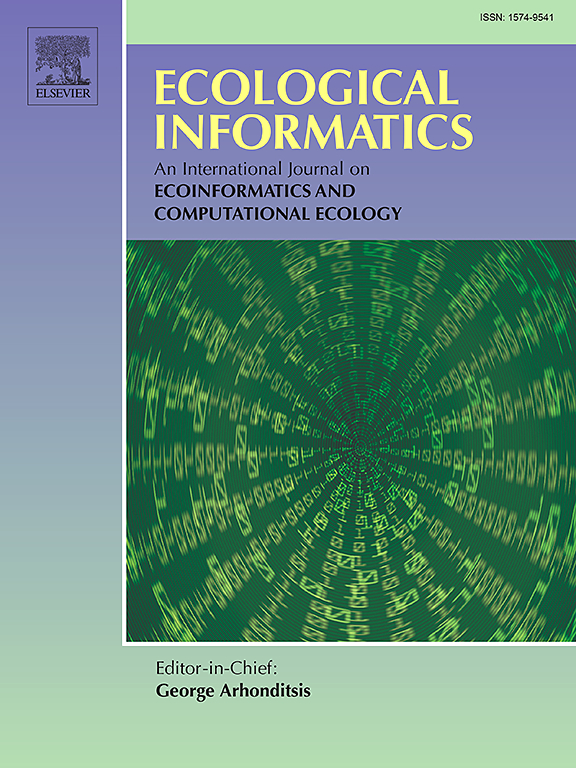干旱对典型大型湖泊漫滩湿地不同植被净初级生产力影响的量化研究
IF 7.3
2区 环境科学与生态学
Q1 ECOLOGY
引用次数: 0
摘要
湿地生态系统是全球碳和水循环的重要组成部分,但频繁和严重的干旱对这些生态系统造成了重大破坏。作为全球最重要的拉姆萨尔湿地之一,鄱阳湖漫滩湿地生态系统在气候变化和人类活动的共同影响下面临着严峻的干旱挑战。利用基于过程的生态模型,结合精细湿地植被分类数据,研究了1986 - 2020年鄱阳湖湿地净初级生产力(NPP)的时空动态及其对干旱的响应。结果表明:大部分植被类型的年内NPP呈现双峰特征,年NPP在222.7 ~ 736.3 gC/m2/yr之间;从空间上看,年NPP值在湿地的南部和西部较高,而北部和东部较低。近35 a来,整个湿地年NPP以- 10.4 gC/m2/yr2的斜率呈下降趋势,其中东部地区下降最为显著。干旱显著改变了鄱阳湖湿地NPP的变率。旱季NPP春、冬季略有增加,夏、秋季略有下降。其中,干旱年夏季NPP较正常年下降57.2%,年NPP由正常年的467.4 gC/m2/yr下降至干旱年的389.6 gC/m2/yr。在极端干旱年和温和干旱年夏季,优势群落芦苇-黄毛蕨(Phragmites australis-Triarrhena lutarioriparia)和毛蕊草(Carex cinerascens)的季节NPP分别比正常年下降了77.8和114.5 gC/m2/yr。研究结果有助于理解河漫滩湿地植被对干旱的响应机制,准确评估区域碳收支。本文章由计算机程序翻译,如有差异,请以英文原文为准。

Quantifying the impact of drought on net primary productivity of different vegetations in a typical large lake floodplain wetland, China
Wetland ecosystems are essential components of the global carbon and water cycles, but frequent and severe droughts pose significant disruptions to these ecosystems. As one of the most important Ramsar Wetlands globally, the Poyang Lake floodplain wetland ecosystem is facing severe drought challenges due to the combined impacts of climate change and human activities. This study investigated the spatio-temporal dynamics of net primary productivity (NPP) and its responses to drought in the Poyang Lake wetland from 1986 to 2020, using a process-based ecological model integrated with refined wetland vegetation classification datasets. The results indicated that the intra-annual NPP for most vegetation types exhibited two peaks, and the annual NPP ranged from 222.7 to 736.3 gC/m2/yr. Spatially, the high annual NPP values occurred in the southern and western regions of the wetland, while low values were found in the northern and eastern regions. Over the past 35 years, annual NPP decreased with the slope − 10.4 gC/m2/yr2 across the entire wetland, with the most significant decline observed in the eastern region. Drought significantly altered NPP variability in the Poyang Lake wetland. Seasonal NPP slightly increased in spring and winter but decreased in summer and autumn during dry years. Specifically, the NPP declined by 57.2 % in the summer of dry years compared to that of normal years, causing annual NPP to decrease from 467.4 gC/m2/yr in normal years to 389.6 gC/m2/yr in dry years. Notably, the seasonal NPP of dominant communities, i.e., Phragmites australis-Triarrhena lutarioriparia, and Carex cinerascens, decreased by 77.8 and 114.5 gC/m2/yr in the summer of extreme drought and mild drought years, respectively, compared to normal years. The findings of this study contribute to understanding the response mechanisms of floodplain wetland vegetation to intensified droughts and accurately assessing regional carbon budgets.
求助全文
通过发布文献求助,成功后即可免费获取论文全文。
去求助
来源期刊

Ecological Informatics
环境科学-生态学
CiteScore
8.30
自引率
11.80%
发文量
346
审稿时长
46 days
期刊介绍:
The journal Ecological Informatics is devoted to the publication of high quality, peer-reviewed articles on all aspects of computational ecology, data science and biogeography. The scope of the journal takes into account the data-intensive nature of ecology, the growing capacity of information technology to access, harness and leverage complex data as well as the critical need for informing sustainable management in view of global environmental and climate change.
The nature of the journal is interdisciplinary at the crossover between ecology and informatics. It focuses on novel concepts and techniques for image- and genome-based monitoring and interpretation, sensor- and multimedia-based data acquisition, internet-based data archiving and sharing, data assimilation, modelling and prediction of ecological data.
 求助内容:
求助内容: 应助结果提醒方式:
应助结果提醒方式:


